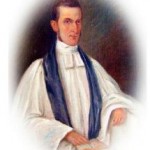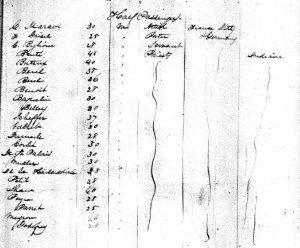Next week we celebrate the lives of two men who were truly, “Indiana Saints” ! I am speaking of Father Benjamin Marie Petit (1811-1839) and Father Anthony Deydier (1788-1864), both of whom were recruited by Bishop Brute. These are two of my favorites. Sunday, February 10th is the 174th anniversary of the death of Fr. Benjamin Marie Petit. Monday, February 11th is the 149th anniversary of the death of Father Deydier.
The Church has many “Saints“. The definition of Saint is:
A person officially recognized, especially by canonization, as being entitled to public veneration and capable of interceding for people on earth.
A person who has died and gone to heaven.
Although Fr. Petit does not meet the criteria that says “Officially recognized, especially by canonization” I believe he meets all the other criteria. And so, today we remember that 174 years ago, Father Petit died in Saint Louis.  The cause of his death was typhoid fever which he contracted along with many, many Pottawatomi Indians who had been forced from their lands in Indiana and forced to march across the middle west to Kansas. But that is the end of the story of a holy and heroic life, albeit a short one!
The cause of his death was typhoid fever which he contracted along with many, many Pottawatomi Indians who had been forced from their lands in Indiana and forced to march across the middle west to Kansas. But that is the end of the story of a holy and heroic life, albeit a short one!
Benjamin Marie Petit, was born in the city of Rennes, France in 1811. He attended university and law school and after three years as a lawyer, he entered the Seminary of St. Sulpice in 1835.  In June of 1836 the young Breton came to the United States with Bishop Brute to serve the Church in the missionary territory of Indiana. He wrote to his mother in April of 1836 and told her that he was going to join Bishop Brute in Indiana. His family protested, apparently because of his fragile health. However, Petit insisted, and he left France in June aboard the “Francis Depau”, sailing from LeHavre. [Note: click on the image to see the entire list of those who accompanied Brute to Indiana] They arrived in New York on July 21, 1836. He was then sent on to Vincennes.
In June of 1836 the young Breton came to the United States with Bishop Brute to serve the Church in the missionary territory of Indiana. He wrote to his mother in April of 1836 and told her that he was going to join Bishop Brute in Indiana. His family protested, apparently because of his fragile health. However, Petit insisted, and he left France in June aboard the “Francis Depau”, sailing from LeHavre. [Note: click on the image to see the entire list of those who accompanied Brute to Indiana] They arrived in New York on July 21, 1836. He was then sent on to Vincennes.
By the end of the year he had received Minor Orders and then in September of 1837 he was ordained a Deacon and on October 14, 1837 he was ordained a priest at Vincennes by Bishop Brute.
His wish had always been to serve the Indians and with the death of Father Louis DeSeille, his wish had been granted.
You can read more on Fr. Petit as well as other”Indiana Saints” by going to Indiana Saints located on this site.
Finally, here is a touching excerpt from a letter that Petit wrote to his mother, dated October 15, 1837, just one day after his ordination:
“I am now a priest, and the hand that is writing to you bore Jesus Christ this morning! How can I express to you all that I should like to say, and yet, how can I not wish to say something of what no tongue can express? “¦When I think that in two days I shall start from here all alone, going nearly three hundred miles to bestow sacraments “” graces ratified in heaven “” among people whom I do not know at all, but to whom God sends me ““ I tremble at the thought of my nothingness. “¦How deeply do I feel myself penetrated by St. Paul’s thought, that God loves to accomplish great things by using that which is nothing”¦”
Read more about Petit and the Pottawatomi tragedy by visiting:
- The Trail of Death and Maxinkuckee’s Chiefs
Potawatomi Web-“Trail of Death” map
St. Rose Philippine Duchesne
History_of_the_Potawatomis
Certainly, this man is a Saint”¦
February 11th marks the anniversary of the death of another Indiana Saint, Father Anthony Deydier. He is another that I admire very much, but I’ve always had trouble trying to find out anything about him. I’ve never been able to find a picture or painting of him. I want very much to put some information about him out into the world, but I don’t have a lot of it or it is disjointed.
However, here is most of what I have so far. Deydier is one of the unsung heroes of the earliest days of Catholic Church History in Indiana. What is even more amazing is that he was almost 50 years old before he was ordained. We’ve become accustomed, somewhat, to late vocations, but in the 1830’s ordaining a man who was 50 years old was almost unheard of
In the History of Vanderburgh County it was written:
It was a noticeable feature of the Catholic priesthood in the pioneer days that wherever they found a community, no matter how small or how widely scattered, wherein they could establish a mission, there the cross was erected and the protecting care of the church spread over the inhabitants. No hardship was accounted too severe and no sacrifice too great to stand in the way of the propagation of a religion which they believed to declare the voice and will of God. The first information of any Catholics residing in the vicinity of Evansville, was communicated in the fall of 1836, to the Right Rev. Gabriel Brute, first bishop of Vincennes, by Rev. Father Buteux, and the companions of his journey, who lodged on their arrival here, at the Mansion House, then kept by Francis Linck, a citizen well remembered to this day and esteemed by all the older inhabitants of the city. Mr. Linck, born in 1774, was a native of Stockheim, in Wurtemburg, and in 1836 was the only Catholic in Evansville, except perhaps the late John Walsh.
In March, 1837, Very Rev. Father De la Hielandiere, vicar-general of the Rev. Bishop, accompanied by Rev. Father Shawe, visited Evansville with a view of establishing a mission, and on the 3rd day of May, following, Rev. Father Anthony Deydier was dispatched to take charge of the mission. Father Deydier was born in France, April 30, 1788, and was ordained a priest at the cathedral of Vincennes, March 25, 1837. Very few knew that he had reached the full strength of his manhood when he took upon himself holy orders, and was placed in charge of the mission in this city. While here he lived a blameless and well spent life, unobtrusive in his deportment, but with a kind word for all. After almost a year’s residence at the house of Mr. Linck, in January, 1838, he built a lodge room, 10×15 feet size, at the corner of Fifth and Chestnut streets. Here he made his abode, using his little room as a dwelling and for chapel purposes for about three years. For Sabbath day services larger rooms at the homes of Catholics were occasionally used. He labored heroically among his people, did much missionary work in the country adjacent to Evansville, and in 1838 made a successful trip to the east to raise funds for the erection of a church building. The history of Catholicism in Evansville since that time is the history of a wonderful growth. The worthy priest who stood by the church in its infancy, lived to see it become rich and powerful with a numerous priesthood within the territory where he once labored alone – lived to see a sturdy oak grown from the acorn planted by his hands. When old age and increasing infirmities had impaired his usefulness, he retired from the active ministry and, returning to Vincennes, passed the evening of his life in comparative rest, greatly beloved by all who knew him. His death occurred February 11, 1864. 1
There is another web site, called “Ameri Catholic” and they too pay homage to those early missionaries, especially the French. They wrote:
Born in France (perhaps Alsace and Lorraine where this surname is common), in 1788, he entered the Seminary of St. Sulpice, where he follows the likely course of Abbot Simon Brute de Rémur, later Bishop of Vincennes (Indiana) who taught theology since 1808. In all cases, it is with the abbots Brute Guy Chabrat Derigaud Jacques, Julian Bishop Benedict Flaget Romeuf and, while the new bishop of Bardstown (Kentucky) came to France to recruit priests and seminarians, he sailed from Bordeaux the United States June 10, 1810. Ordained deacon in 1812, he refused the priesthood and taught for four years at Mount St. Mary’s in Emmitsburg (Maryland) where the priest teaches Brute. These past four years, we find him at Albany (New York) as a tutor. But, without doubt, the discussions he had with Father Brute at Mount St. Mary’s, make him reconsider his denial of the priesthood since March 25, 1837, he was ordained priest by Bishop Brute, of Vincennes first ordinary (since 1834), in the Cathedral of St. Francis Xavier in this city. Upon his ordination, this late vocation, is sent in November 1837, in Evansville (Indiana) where he stayed until 1859, except for a tour he performed in September 1838 to raise the money for the diocese, accompanied by a young Ann (Nancy) Brown the novitiate of the Sisters of Charity of Emmitsburg, and an itinerant ministry in Gibson County (Indiana) from 1838 to 1840. In 1838 he began construction of the Assumption Church, the first Catholic Church in Evansville, even to monitor the manufacture of bricks – and it was today, the Feast of the Assumption, the opportunity to report this church is that Father Deydier had built: it was razed in 1872. 2
Like Petit, Deydier too, is an Indiana Saint!! Remember them on February 10th and 11th and ask for their prayers — for yourself and for the Church in Indiana.